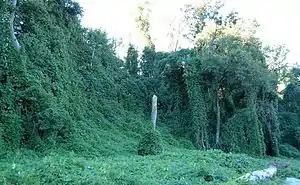Invasive species in the United States
Invasive species are a significant threat to many native habitats and species of the United States and a significant cost to agriculture, forestry, and recreation. The term "invasive species" can refer to introduced/naturalized species, feral species, or introduced diseases. Some introduced species, such as the dandelion, do not cause significant economic or ecologic damage and are not widely considered as invasive. Economic damages associated with invasive species' effects and control costs are estimated at $120 billion per year.[1]
_(8387580552).jpg.webp)
Notable invasive species
| Picture | Common Name | Species Name | Introduced | Control Measures | Notes |
|---|---|---|---|---|---|
 | Kudzu | Pueraria lobata | Southern U.S. | Mowing, herbicides, conservation grazing | Known as "the vine that ate the South", forms dense monocultures that outcompete native ground cover and forest trees. Can grow up to one foot per day. |
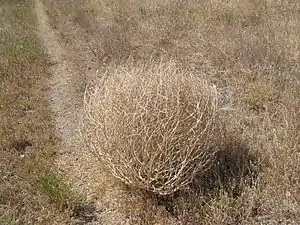 | Common tumbleweed | Kali tragus | Throughout North America | Managed grazing | Introduced through imported flaxseed from Russia that was contaminated with Kali seeds. Although invasive, it was used in Westerns to symbolize frontier areas of the United States. |
 | Privet | Ligustrum spp. | Southeastern U.S. | Mechanical removal, herbicides | Highly invasive in urban areas and forested area of the southeastern U.S. |
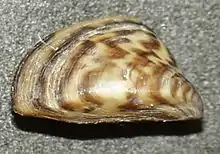 | Zebra mussel | Dreissena polymorpha | Great Lakes, U.S. waterways & lakes | Ballast water transport bans, manual removal from clogged pipes | Initially spread by ballast tanks of oceangoing vessels on the Great Lakes, now spread lake-to-lake by trailer-drawn boats. May be a source of avian botulism in the Great Lakes region. |
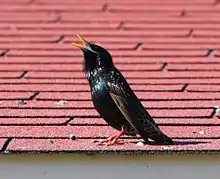 | Common starling | Sturnus vulgaris | Lower 48 states | Hunting, trapping | Introduced in 19th century as part of an effort to bring all species mentioned in Shakespeare's works to the United States. 100 birds released in Central Park have spread all over the mainland U.S. |
 | Brown tree snake | Boiga irregularis | Guam | Dog-sniffing of incoming ships, paracetamol as poison | Has reached densities on Guam of up to 100 snakes per hectare, caused extinction on Guam of at least 12 bird species |
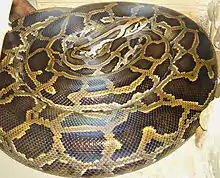 | Burmese python | Python bivittatus | Everglades | Hunting season created | Introduced by hurricane damage to breeding facilities. |
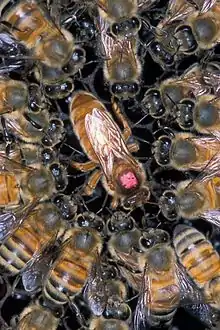 | Africanized bee | Apis mellifera hybrid | Southwestern U.S. | Cold weather has limited spread | Hybrid of African and European honeybees created in Brazil in the 1950s, described as "Killer bees." While individually no more venomous than European honeybees, attacks are particularly violent and usually involve large numbers of stings, which can be cumulatively fatal to animals and people. |
 | Asian carp | Multiple Cyprinidae | Mississippi River and tributaries | Rotenone poison, electric barriers | Have the habit of jumping out of the water, which can injure boaters. Introduced to eat algae in fish ponds in Southern U.S., escaped during flood events. |
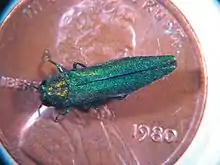 | Emerald ash borer | Agrilus planipennis | Eastern U.S. | Culling infected stands, bans on firewood transport | Threatens to severely reduce or eliminate the ash lumber industry of U.S., worth an estimated value of $25.1 billion per year |
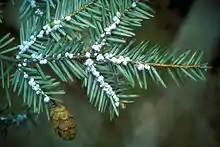 | Hemlock woolly adelgid | Adelges tsugae | Eastern U.S. | Insecticide treatment | Could kill most eastern hemlocks in the U.S. within the next decade |
 | Multiflora rose | Rosa multiflora | Eastern U.S. | Manual removal, herbicides[2] | Introduced for erosion control and promoted as a "living fence" to attract wildlife, now competes with native understory plants |
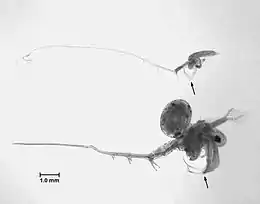 | Spiny waterflea | Bythotrephes longimanus | Great Lakes | Ballast water transport bans | Competes with native fish for prey, spines prevent many native fish from eating it as prey |
 | Snakehead | Channa argus | East Coast fresh water | Possession of a live specimen is illegal in many U.S. states.[3] | Snakeheads can become invasive species and cause ecological damage because they are apex predators.[4] |
.jpg.webp) | Giant African land snail | Lissachatina fulica | Florida | Pest control | This invasive species was smuggled into Florida from Africa. Since they need calcium to build their shells, they attach themselves to concrete, which in many cases is house foundations, weakening house structures. |
 | Lionfish | Pterois | Southern U.S. | Lionfish derbies[5] | Lionfish compete for food with native fish species. They have no natural predators because of their venomous spines.[6] |
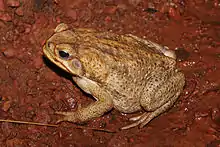 | Cane toad | Rhinella marina | Florida[7] and Hawaii[8] | Pest control | They pose as threats to animals since they are toxic.[7] |
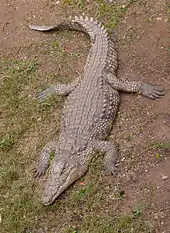 | Nile crocodile | Crocodylus niloticus | Florida | Unknown | Several specimens have been recently captured in South Florida, though no signs have been found that the population is reproducing in the wild.[9][10] |
.jpg.webp) | Rusty crayfish | Orconectes rusticus | Across the states | The larger size and aggressive nature of rusty crayfish that have been introduced to a body of water makes it harder for them to be preyed upon by native species of fish, which are not accustomed to crayfish fighting back against them.[11] | |
Economic impact
The economic impacts of invasive species can be difficult to estimate, especially when an invasive species does not affect economically important native species. This is partly because of the difficulty in determining the non-use value of native habitats damaged by invasive species and incomplete knowledge of the effects of all of the invasive species present in the U.S. Estimates for the damages caused by well-known species can vary as well. The Office of Technology Assessment (OTA) has estimated zebra mussel economic effects at $300,000 per year, while a United States Army Corps of Engineers study put the number at $1 billion per year. The United States government spends an estimated $1 billion annually to recover from the invasive Formosan termite, investing $300,000,000 billion of this budget in areas surround New Orleans, a major port city.[12] Estimates of total yearly costs controlling invasive species range from $1.1 billion to $137 billion per year.[13]
In 1993, the OTA estimated that a total of $100 million is invested annually in invasive species aquatic weed control in the U.S.[14] Introduced rats cause more than $19 billion per year in damages,[15] exotic fish cause up to $5.4 billion annually, and the total costs of introduced weeds are estimated at around $27 billion annually.[16] The total damage to the native bird population from invasive species is approximately $17 billion per year. Approximately $2.1 billion in forest products are lost each year to invasive plant pathogens, and a conservative estimate of the losses to livestock from exotic microbes and parasites was $9 billion per year in 2001.[17]
Government policies and management efforts
The federal government has historically promoted the introduction and widespread distribution of species that became invasive, including multiflora rose, kudzu, and others for numerous reasons. Before the 20th century, numerous species were imported and released without government oversight, such as the gypsy moth and house sparrow. Over 50% of flora recognized as invasive or noxious weeds were deliberately introduced to the United States, by either government policy or individuals.[18] Current government policy can be broadly separated into two categories: preventing entry of a potential invasive species and controlling the spread of species already present. This is carried out by different government agencies, depending on what types of damage a species can cause.
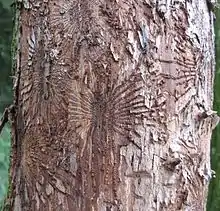
Regulations
The Lacey Act of 1900 was originally designed to protect game wildlife. Its role has increased to prohibit parties from bringing non-native species into the country that have the potential to become invasive. The Lacey Act gives the United States Fish and Wildlife Service (FWS) the power to list a species as "injurious" and regulate or prohibit its entry into the U.S.[19] The Alien Species Prevention and Enforcement Act of 1992 makes it illegal to transport through the mail a plant or animal deemed injurious. The FWS concerns itself mostly with the invasive species likely to threaten sensitive habitats or endangered species.
The United States Department of Agriculture (USDA) is also involved in preventing the introduction of invasive species, largely through the Animal and Plant Health Inspection Service, or APHIS. APHIS was originally tasked with preventing damage to agriculture and forestry from alien species, pests, or diseases, but has had its mission expanded to include preventing invasive species spread as well.[20] This includes identifying potential pests and diseases, assisting in international and domestic eradication efforts, and the Smuggling Interdiction and Trade Compliance Program, designed initially to deal with illegally imported produce, but now tasked with preventing the entry of exotic pests, diseases, and potentially invasive species.[21] APHIS also enforces bans against interstate transport of pests, diseases, and species listed as injurious, noxious weeds, or nuisance species. An example of the USDA banning imports is the ban on fresh mangosteen fruit because of concerns about fruit flies from southeast Asia. This ban originally allowed only frozen or canned fruit, but now allows for fresh irradiated fruit to enter.[22]
Control
Many invasive species are spread inadvertently by human activities, such as seeds stuck to clothing or mud transporting firewood, or through ballast water. The government has instituted several different policies related to different pathways the invasive species may be spread. For example, quarantines on a federal and state level exist for firewood across the Eastern United States in an attempt to halt the spread of the emerald ash borer, gypsy moth, oak wilt, and others. Transporting firewood out of quarantine zones can result in a fine of up to $1 million and 25 years in jail, but punishments are usually much lower.[23]
The techniques available for controlling the spread of invasive species can be broadly defined into six categories:[24]
- Cultural practices, including controlled burns and timbering. An example of this in action is the use of prescribed burns in the Everglades to control Melaleuca quinquenervia trees. The burns destroy Melaleuca but not native species which have adapted to wildfires, which were common but are now suppressed.[25]
- Interference with dispersal, which may include fencing, reducing accidental seed transport, and the construction of barriers, such as the electric barriers to prevent the spread of Asian carp.
- Mechanical removal, including mowing, harvesting, manual removal, trapping, & culling. Many invasive plants, such as garlic mustard, can regrow quickly after mowing and must be removed by the roots or chemically.
- Chemical control, which may include the use of approved pesticide or herbicide, or vaccines to control invasive diseases. Sea lampreys in the Great Lakes have had their numbers significantly reduced by a lampricide that kills larvae, which hatch in streams, before they can enter the lakes. The lampricide is responsible for reducing the sea lamprey population in the Great Lakes from over 3 million in the 1950s to around 450,000 today, which has potentially rescued several Great Lakes fisheries.[26]
- Biological control, which can involve the release of specific predators/herbivores, parasites, or diseases designed to control an invasive species without damaging native ones. One example of this is the city of Chattanooga's use of goats to control kudzu growing on mountain ridges. The goats, guarded from predators by llamas, eat the vine often enough to slowly starve the roots, killing the plant. This method is much cheaper than the repeated mowing or herbicidal spraying that would otherwise be necessary.[27] Goats reach areas that are inaccessible to machines and have multi-chambered stomachs which coupled with their grazing technique mean that goats leave few seeds behind to sprout again.[28]
- Interference with reproduction, which can include the release of mating-disrupting pheromones or the release of sterile males. Field tests are underway to study the control of sea lampreys in the Great Lakes by the use of pheromone-baited traps in streams, in addition to current chemical controls. When female sea lampreys return to the stream to breed, they are drawn to the traps and captured, preventing reproduction.[26]
An integrated pest management (IPM) approach, as defined by the National Invasive Species Council, uses scientific data and population monitoring to help determine the most efficient control strategy, which is usually a combination of several of the methods listed above. Agencies are encouraged to use an adaptive management strategy, involving regular reviews on the efficiency of their policies and conduct research into better methods.[24]
Inter-department cooperation
Invasive species control is not overseen by a single government agency. For example, eight agencies (divisions) of the USDA work on invasive species issues, including the Agricultural Research Service, Animal and Plant Health Inspection Service, Cooperative State Research, Education, and Extension Service, Economic Research Service, Farm Service Agency, Foreign Agricultural Service, United States Forest Service, and the Natural Resources Conservation Service.[29] Different invasive species are controlled by different agencies. For example, policies aimed at controlling the emerald ash borer are undertaken by the USDA because national forests, the body coordinating emerald ash borer control efforts, are within the USDA.[30] The National Invasive Species Council (NISC) was created by executive order in 1999 and charged with promoting efficiency and coordination between the numerous federal invasive species prevention and control policies. The NISC is co-chaired by the secretaries of the three federal departments that are charged with invasive species control: Department of Interior, Department of Commerce, and the USDA. [31] Many state efforts use a similar council model to coordinate state agencies.
Education and outreach

Many of the policies used to contain invasive species, such as firewood transport bans or cleaning shoes and clothes after hiking, are effective only when the general public knows of their existence and importance. Because of this, numerous programs have been implemented to inform the public about invasive species. This includes placing signs at boat ramps, campsites, state borders, hiking trails, and numerous other locations as reminders of policies and potential fines associated with breaking policies. There are also numerous government programs aimed at educating children,[32] as well as promoting volunteer efforts at removal and the many ways citizens can prevent the spread of invasive species.[33]
Invasive species by area
Great Lakes
Current efforts in the Great Lakes ecoregion focus on measures that prevent the introduction of invasive species. As a major transport area, a number of invasive species have already been established within the Great Lakes. In 1998, the United States Coast Guard, in accordance with the National Invasive Species Act of 1996, established a voluntary ballast water management program. In 2004 this voluntary program became mandatory for every ship entering U.S.-controlled waters.[34] Current measures are among the most stringent in the world and require ships entering from outside the Exclusive Economic Zone to flush ballast water in open seas or retain their ballast water for the length of their stay in the Great Lakes.[35][36] Failure to comply with the U.S. Coast Guard’s regulations can result in a class C felony.[37]
Another preventative measure in the Great Lakes region is the presence of an electrified barrier in the Chicago Sanitary and Ship Canal. The barrier is meant to keep Asian carp from reaching Lake Michigan and the other Great Lakes. On December 2, 2010, Michigan, Ohio, Pennsylvania and Wisconsin were denied their request to force the closing the canal by the United States district court.[38][39] The closing of the canal would have once again separated Lake Michigan and the Mississippi river system. States argued that the canal, and the Asian carp in it, posed a risk to $7 billion worth of industry.[40] Currently the electric barrier is the only preventative measure and some question its effectiveness, particularly following the discovery of Asian carp DNA past the barrier.[41] The discovery of DNA of Asian carp could be linked to live bait used around the Great Lakes region. The method for identifying the DNA is called environmental DNA (eDNA) surveillance. This method uses DNA that is left in the environment to identify species in low abundances.[42]
Rocky Mountains
The USDA Rocky Mountain Research Station has a specific Invasive Species Working Group[43] to do the research about invasive species in Rocky Mountain region. The Invasive Species Working Group focuses on four key areas: prediction and prevention; early detection and rapid response; control and management; restoration and rehabilitation.[13] Specific approaches include prioritizing of invasive species problems, increased collaboration among agencies regarding those problems, and accountability for the responsible use of the limited resources available for invasive control.[44]
Invasive species of particular concern in the Rocky Mountain region include: cheatgrass; leafy spurge; tansy ragwort; spotted knapweed; bufflegrass; saltcedar; white pine blister rust; armillaria root rot; introduced trout species; golden algae; spruce aphid; and banded elm bark beetle.[45]
Colorado River
Already stressed by water management and damming, the Colorado River is losing its big-river fish community to combined effects of predation and competition by introduced non-native fishes. This fish community includes four large fishes that are listed as endangered by the U.S. Fish and Wildlife Service. One of these, the Colorado pikeminnow, is the largest minnow native to North America and is known for its spectacular fresh water spawning migrations and homing ability. Despite a massive recovery effort, its numbers are in decline. Hampered by a loss of about 80% of its habitat, the young of this once abundant fish is overwhelmed in its nursery habitat by invasive small fishes (such as red shiner and fathead minnow), whose numbers are as high as 90% of the standing stocks. Its juveniles and adults now must also compete with and are preyed upon by introduced northern pike, channel and flathead catfishes, largemouth and smallmouth basses, common carp, and other fishes.[46] However, the listing of these non native sport fish as invasive is controversial, as the fish are popular among anglers, who criticize the science used by government agencies and assert that nonnative species are largely a scapegoat in the decline of endemic Colorado River basin fish, blaming changes to the environment in the forms of dams and water diversions as being the main cause [47]
Florida Everglades
In 1994, the Everglades Forever Act of 1994 was passed to help in controlling Florida's water supply, recreation areas, and diverse flora and fauna.[48] In addition to control and prevention measures the act also calls for efforts to monitor the distribution of known invasive species.[49]
One invasive species occurring in the Everglades that can have serious consequences is the Burmese python. Between 2000 and 2010, approximately 1,300 of the snakes were removed from the Everglades.[50] Currently the National Park Service is researching control measures for the Burmese python in order to limit the species effects on the delicate Everglades ecosystem.[51]
Invasive species by state
Arizona
California
California has created a policy system towards invasive species, including Invasive Species Council of California (ISCC), California Invasive Species Advisory Committee (CISAC) and California Invasive Plant Council (Cal-IPC), a non-profit organization. The ISCC represents the highest level of leadership and authority in state government regarding invasive species. The ISCC is an inter-agency council that helps to coordinate and ensure complementary, cost-efficient, environmentally sound and effective state activities regarding invasive species. CISAC advises the ISCC, and created the California list of invasive species.[52] California has many diverse ecoregions, and numerous endemic species that are at risk from invasive species.[53]
Connecticut
Florida
Invasive species in Florida currently make up more than 26% of the animal population and a full one third of the flora population.[54] In 2015, the presence of the invasive land planarian Platydemus manokwari was recorded from several gardens in Miami. Platydemus manokwari is a predator of land snails and is considered a danger to endemic snails wherever it has been introduced.[55]
Hawaii
Measures to prevent the introduction and spread of invasive species are coordinated by the Hawaii Invasive Species Council.[56] Currently the council is broken into five committees which focus on different areas of invasive species control. These focus areas are: prevention, management of established pests, increased public awareness, research and technology, and monetary resources.
Currently, Hawaii requires inspection of any and all plant, animal and microorganism transports.[57] This includes transports from the mainland in addition to transports occurring between islands. Travelers are required to fill out a declaration form for each journey. Failure to declare these transports can result in up to one year imprisonment or a $250,000 fine.[58] Many potential invasives or carriers for invasives require permits and quarantine periods before entry to the state is allowed.[59]
In addition, there are other preventative measures such as a hotline for reporting sightings of known potential invaders like the brown tree snake.[60]



Idaho
The Idaho Department of Agriculture has around 300 introduced or exotic species listed with 36 classified as noxious weeds. The legal designation of noxious weed for a plant in Idaho can use these four criteria:[61]
- It is present in but not native to state-province-ecosystem.
- It is potentially more harmful than beneficial to that area.
- Its management, control, or eradication is economically and physically feasible.
- The potential adverse impact of it exceeds the cost of its control.
Some of the plants on Idaho's noxious weed list that are harmful or poisonous are:
- Leafy spurge (Euphorbia virgata): native to Eurasia. It has a milky latex in all its parts that can produce blisters and dermatitis in humans, cattle, and horses and may cause permanent blindness if rubbed into an eye.
- Poison hemlock (Conium maculatum): native to Europe. It contains highly poisonous alkaloids toxic to all classes of domesticated grazing animals. Agonopterix alstroemeriana is used as a biological control method for the plant, which in high larval numbers can kill large areas of the poisonous plant.
- Russian knapweed (Acroptilon repens): native to the Caucasus in southern Russia and Asia. It causes chewing disease in horses.
- Tansy ragwort: native to Eurasia. All parts are poisonous, it causes liver damage to cattle and horses, while it affects sheep to a lesser extent.
- Toothed spurge (Euphorbia dentata): native further east and south, but not native to Idaho.[62] A milky latex exists in all parts of the plant that can produce blisters and dermatitis in humans, cattle, and horses. It may cause permanent blindness if rubbed into the eye.
- Yellow starthistle (Centaurea solstitialis): native to the Mediterranean basin area and Asia. It causes death and chewing disease in horses.
- Yellow toadflax (Linaria vulgaris): native to Europe. It contains a poisonous glucoside that may be harmful to livestock.
Louisiana
New Orleans, the "gateway to the Mississippi", is a porous port city with rich soils. In turn, many aquatic plants are introduced to the region, making Louisiana the state with the second largest list of invasive aquatic species,[63] second to Florida.
The "Dirty Dozen"[64] details a list of the United States' most destructive invasive species. Of the twelve, four are identified in the state, including the zebra mussel, tamarisk, hydrilla, and Chinese tallow.
Maryland
Nevada
New Jersey
New Mexico
New York
The New York State Department of Environmental Conservation works with stewards of natural resources, non-profits and citizen scientists to detect, record and manage invasive species. These collaborations are organized into 8 Partnerships for Regional Invasive Species Management (PRISMs) throughout the state. PRISMS perform the following tasks: plan regional invasive species management;develop early detection and rapid response capacity; implement eradication projects; educate the public in cooperation with DEC contracted Education and Outreach providers; coordinate PRISM partners; recruit and train volunteers; support research through citizen science.[65][66]
Counties of New York list invasive species in varying order of threat.[67][68][69][70][71] Insects considered invasive include: Asian longhorned beetle; emerald ash borer; and spotted lanternfly.
Oregon
Pennsylvania
Pennsylvania has a Governor's Invasive Species Council which devises action plans to deal with threats to the Commonwealth's agricultural and natural resources.[72] Spotted lanternfly is one of the newest and most urgent threats to businesses in Pennsylvania including vineyards and wineries, orchards and hops producers.[73][74]
Rhode Island
Species of concern in Rhode Island include burning bush (Euonymus alatus), Oriental bittersweet (Celastrus orbiculatus), and purple loosestrife (Lythrum salicaria).[75]
Texas
Utah
West Virginia
Wisconsin
See also
References
- David Pimentel, Rodolfo Zuniga, Doug Morrison. Update on the environmental and economic costs associated with alien-invasive species in the United States. Ecological Economics. 52 (2005) 273-288.
- "Invasive Species: Plants - Multiflora Rose (Rosa multiflora)". Invasivespeciesinfo.gov. Retrieved 2012-03-19.
- "Archived copy" (PDF). Archived from the original (PDF) on 2015-10-10. Retrieved 2015-07-21.CS1 maint: archived copy as title (link)
- "Fishzilla: Snakehead Invasion". Wild. National Geographic Channel. Archived from the original on 2008-05-15. Video clip titled: "The Northern Snakehead fish wreaks havoc".}}
- https://www.reef.org/lionfish-derbies
- https://blog.nationalgeographic.org/2016/08/29/saving-the-reef-lionfish-in-florida/
- "Cane Toad". www.invasivespeciesinfo.gov. National Invasive Species Information Center | USDA. Retrieved 24 July 2020.
- "Cane Toad (Rhinella marina) Ecological Risk Screening Summary" (PDF). U.S. Fish and Wildlife Service. Retrieved 24 July 2020.
- Bakalar, Nicholas (2016-05-23). "Nile Crocodiles Found Really Far Out of Africa. In Florida". The New York Times. ISSN 0362-4331. Retrieved 2016-05-24.
- Rockfort; Krysko; Mazzotti; Shirley; Parry; Wasilewski; Beauchamp; Gillette; Metzger; Squires & Somma (2016). "Molecular analysis confirming the introduction of Nile crocodile, Crocodylus niloticus Laurenti 1768 (Crocodylidae), in Southern Florida, with an assessment of potential for establishment, spread, and impacts". Herpetological Conservation and Biology. 11 (1): 80–89.
- Hein, Catherine L; Roth, Brian M; Ives, Anthony R; Zanden, M Jake Vander (2006). "Fish Predation and Trapping for Rusty Crayfish (Orconectes rusticus) Control: A Whole-lake Experiment". Canadian Journal of Fisheries and Aquatic Sciences. 63 (2): 383. doi:10.1139/f05-229.
- "Louisiana Invasive Species". is.cbr.tulane.edu. Retrieved 2016-11-17.
- "Invasive Species Research - Rocky Mountain Research Station - USDA Forest Service". Rmrs.nau.edu. Retrieved 2012-03-19.
- OTA, 1993. Harmful Non-Indigenous Species in the United States. Office of Technology Assessment, United States Congress, Washington, DC.
- USDA, 2001. Agricultural Statistics. U.S. Department of Agriculture, Washington, DC
- Pimentel, D., Lach, L., Zuniga, R., Morrison, D., 1999. Environmental and economic costs associated with introduced nonnative species in the United States. Manuscript, pp. 1– 28.
- David Pimentel, Rodolfo Zuniga, Doug Morrison. Update on the environmental and economic costs associated with alien-invasive species in the United States. Ecological Economics. 52 (2005) 273-288
- The United States Naturalized Flora: Largely the Product of Deliberate Introductions Richard N. Mack and Marianne Erneberg. Annals of the Missouri Botanical Garden. Vol. 89, No. 2 (Spring, 2002), pp. 176-189
- Nation marks Lacey Act centennial, 100 years of federal wildlife law enforcement. US Fish and Wildlife Service. Retrieved on July 7, 2010.
- "Usda - Aphis - About Aphis". Aphis.usda.gov. 2007-10-18. Retrieved 2012-03-19.
- "USDA - APHIS - International Safeguarding - Services". Aphis.usda.gov. 2011-06-28. Retrieved 2012-03-19.
- Karp, David (8 August 2007). "Mangosteens Arrive, but Be Prepared to Pay". The New York Times. Retrieved 22 May 2010.
- "Web Page Redirect - Wisconsin Department of Natural Resources". Dnr.wi.gov. Archived from the original on 2012-02-09. Retrieved 2012-03-19.
- "Guidelines for ranking invasive species control projects. Volume I." National Invasive Species Council. May, 2005. http://www.invasivespecies.gov/global/CMR/CMR_documents/NISC%20Control%20and%20Management%20Guidelines.pdf
- "In Practice - Prescribed Burning: Management Methods - Managing Invasive Plants". Fws.gov. 2009-02-18. Retrieved 2012-03-19.
- "Pheromones in river traps attract sea lampreys". Great Lakes Echo. 2009-05-11. Retrieved 2012-03-19.
- Emery, Theo (5 June 2007). "In Tennessee, Goats Eat the 'Vine That Ate the South'". The New York Times.
- Jolly, Joanna. "The goats fighting America's plant invasion". BBC Magazine. Retrieved 15 January 2015.
- USDA "Do No Harm" 2009 Report- Retrieved 2017-11-25
- "Emerald Ash Borer Beetle (EAB) | Stop The Beetle". Stopthebeetle.info. Retrieved 2012-03-19.
- Emerton, L. and G. Howard, 2008, A Toolkit for the Economic Analysis of Invasive Species. Global Invasive Species Programme, Nairobi.
- "Invasive Species: Outreach and Awareness". Invasivespeciesinfo.gov. 2012-03-14. Retrieved 2012-03-19.
- "What Can You Do - Invasive Species - U.S. Fish and Wildlife Service". Fws.gov. 2012-01-19. Retrieved 2012-03-19.
- "Ballast Water Management". Uscg.mil. Retrieved 2012-03-19.
- "Seaway System - The Environment - Ballast Water". Greatlakes-seaway.com. Retrieved 2012-03-19.
- "SERC - Marine Invasions: Mid-ocean Ballast Water Exchange". Serc.si.edu. Archived from the original on 2012-03-19. Retrieved 2012-03-19.
- "Aquatic Nuisance Species". Uscg.mil. 2011-01-04. Retrieved 2012-03-19.
- "Another setback in the legal fight to keep Asian carp out of the Great Lakes". Great Lakes Law. 2010-12-06. Retrieved 2012-03-19.
- "Case: 1:10-cv-04457 Document #: 155 Filed: 12/02/10 Page 1 of 61 PageID #:4980" (PDF). Retrieved 2012-03-19.
- Egan, Dan (2010-01-05). "Illinois fights back over carp lawsuit". JSOnline. Retrieved 2012-03-19.
- "Chicago waterway gets third electric barrier aimed at keeping Asian carp out of Great Lakes". TwinCities.com. Retrieved 2012-03-19.
- Nathan, L. R., Jerde, C. L., Budny, M. L., & Mahon, A. R. (2015). The use of environmental DNA in invasive species surveillance of the Great Lakes commercial bait trade. Conservation Biology, 29(2), 430–439. http://doi.org/10.1111/cobi.12381
- "Invasive Species Working Group - Rocky Mountain Research Station - USDA Forest Service". Rmrs.nau.edu. Retrieved 2012-03-19.
- "A Framework for the Development of the National Invasive Species Management Strategy for the USDA Forest Service" (PDF). Retrieved 2012-03-19.
- "Research Summary and Expertise Directory" (PDF). Retrieved 2012-03-19.
- H.M. Tyus and J.F. Saunders 2000. Nonnative fish control and endangered fish recovery: Lessons from the Colorado River. Fisheries 25(9):17-24)
- https://www.denverpost.com/2007/12/01/pike-at-heart-of-rifle-gap-discussion/
- Florida Statutes Chapter 373.4592, "Archived copy". Archived from the original on 2008-10-28. Retrieved 2008-05-21.CS1 maint: archived copy as title (link)
- Ferriter, "et al" (2001) http://mytest.sfwmd.gov/portal/page/portal/pg_grp_sfwmd_sfer/portlet_prevreport/consolidated_01/chapter%2014/ch14.pdf
- "Injurious Wildlife Species; Listing Three Python Species and One Anaconda Species as Injurious Reptiles". Fish and Wildlife Service. 23 January 2012. Retrieved 19 March 2012.
- "Natural Resources Management - Burmese Pythons" (PDF). Retrieved 2012-03-19.
- California list of invasive species
- "Welcome to the Invasive Species Council of California". Iscc.ca.gov. Retrieved 2012-03-19.
- Ferriter, et al (2001) http://mytest.sfwmd.gov/portal/page/portal/pg_grp_sfwmd_sfer/portlet_prevreport/consolidated_01/chapter%2014/ch14.pdf
- Justine, Jean-Lou; Winsor, Leigh; Barrière, Patrick; Fanai, Crispus; Gey, Delphine; Han, Andrew Wee Kien; La Quay-Velázquez, Giomara; Lee, Benjamin Paul Yi-Hann; Lefevre, Jean-Marc; Meyer, Jean-Yves; Philippart, David; Robinson, David G.; Thévenot, Jessica; Tsatsia, Francis (2015). "The invasive land planarianPlatydemus manokwari(Platyhelminthes, Geoplanidae): records from six new localities, including the first in the USA". PeerJ. 3: e1037. doi:10.7717/peerj.1037. ISSN 2167-8359. PMC 4485254. PMID 26131377.

- "Hawaii Invasive Species Council (HISC)". Hawaiiinvasivespecies.org. 2003-10-29. Archived from the original on 2012-03-21. Retrieved 2012-03-19.
- "Plant Quarantine — Hawaii Department of Agriculture". Hawaii.gov. Retrieved 2012-03-19.
- "Exhibit 3. State of Hawaii Department of Agriculture Plants and Animals Declaration Form" (PDF). Retrieved 2012-03-19.
- "Frequently Asked Questions on Import and Export Regulations of Plant Species". Hawaiiplants.com. 2010-12-15. Archived from the original on 2012-03-23. Retrieved 2012-03-19.
- "Brown Tree Snake Program — Hawaii Department of Agriculture". Hawaii.gov. Retrieved 2012-03-19.
- Prather, Timothy (2002). Idaho's Noxious Weeds. University of Idaho.
- "Plants Profile for Euphorbia dentata (toothed spurge)". plants.usda.gov. Retrieved 6 February 2020.
- "Nonindigenous Aquatic Species". nas.er.usgs.gov. Retrieved 2016-11-17.
- "The dirty dozen: 12 of the most destructive invasive animals in the United States". Washington Post. Retrieved 2016-11-17.
- NYSDEC PRISM Fact Sheet, http://www.dec.ny.gov/docs/lands_forests_pdf/prismfactsheet.pdf
- NY Invasive Species Information, http://nyis.info/index.php
- "New York State Prohibited and Regulated Invasive Plants" (PDF). New York Department of Environmental Conservation. Retrieved October 14, 2019.
- "NY Invasive Species (IS) Info". Cornell Cooperative Extension and NY Sea Grant. Retrieved October 14, 2019.
- "Invasive Plants". New York Botanical Gardens. Retrieved October 14, 2019.
- Ben Axelson. "15 invasive plants that could be wreaking havoc on your yard or garden in Upstate NY". NYUP.com. Retrieved October 14, 2019.
- "Invasive Species". Cornell Cooperative, Dutchess County. Retrieved October 14, 2019.
- "Governors Invasive Species Council". Pennsylvania Department of Agriculture. Retrieved October 15, 2019.
- "Spotted Lanternfly". Pennsylvania Department of Agriculture. Retrieved October 13, 2019.
- "Extremely Terrified Wineries in Bucks Facing Threat From Spotted Lanternfly". Bucks Count Corier Times. Retrieved October 13, 2019.
- "Invasive Species". Rhode Island Wild Plant Society. Retrieved October 13, 2019.
External links
- PlayCleanGo
- Center for Invasive Species and Ecosystem Health
- National Invasive Species Council
- Center for Invasive Species Research
- Center for Environmental and Regulatory Information Systems
- The National Association of Invasive Plant Councils
- Invasive Species Specialist Group
- Invasive Plant Atlas of the United States
- Early Detection & Distribution Mapping System
- Introduced, Invasive, and Noxious Plants Database
- Animal and Plant Health Inspection Service
- National Park Service
- US Forest Service
- US Fish and Wildlife
- National Institute of Food and Agriculture
- Natural Resources Conservation Service
- National Invasive Species Information Center
- Forest Health Protection
- Southern Regional Extension Forestry
- The Cooperative Agricultural Pest Survey
- Invasive Plant Research Laboratory
- Invasive Species and Pollinator Health
- Invasive Insect Biocontrol & Behavior Laboratory
- Southeast Exotic Pest Plant Council
- North American Invasive Species Network
- Global Invasive Species Information Network
- Invasive and Exotic Species of North America
- Invasive Plant Control, Inc.
- Pest Tracker
- "Georgia Invasive Species Task Force". GA Invasives. Retrieved 2020-12-13.
